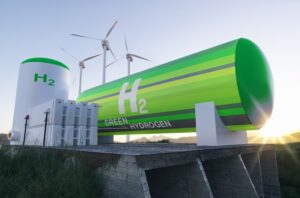This joint initiative can provide an open platform for international partnerships in which global steel companies can source and produce hot-briquetted iron (HBI) in Brazil and accelerate the emerging low-carbon steel industry.
Vale has been actively seeking partners to enable the construction of mega hubs in Brazil, aligned with its strategic objective to foster the country’s low-carbon industry. In these industrial hubs, Vale expects to produce iron ore agglomerates (pellets or briquettes), which will serve as an input to produce HBI, a low-carbon emission steel pre-material, with renewable hydrogen as the reducing agent. The agreement with GEP is another important step in this direction.
“This is a win-win partnership for Brazil and Europe,” said Ludmila Nascimento, Director of Energy and Decarbonization at Vale. “We are leveraging Brazil’s competitive advantages, such as high-quality iron ore and abundant renewable energy, to potentially develop green hydrogen supply, which will enable the offer of a ‘green’ HBI with high added value to European steelmakers. Meanwhile, we are fostering Brazil’s new industrialization, based on the low-carbon economy, and contributing to the fight against climate change.”
Bart Biebuyck, CEO of GEP, commented: “The partnership with Vale is a major milestone on our journey to Net Zero. We are proud to work with the largest producer of direct reduction pellets in the world to help decarbonize the steel sector. The collaboration between our companies aims to bring our leading green hydrogen technology to the core of the hard-to-abate sectors, offering a highly competitive platform for green steel production in Europe and around the world. Together, we are looking forward to accelerating the green hydrogen industry in Brazil.”
The iron and steel industry accounts for approximately 8% of the world’s total carbon emissions, primarily due to the use of coal in blast furnaces. High carbon emissions by the steel industry represent a big challenge for global efforts to reduce greenhouse gas emissions and reach a carbon neutral economy by 2050.
For every ton of steel produced in blast furnaces about 2.0 tons of CO₂ equivalent are released into the atmosphere. In contrast, in the direct reduction route, the HBI produced with green hydrogen as the reducing agent when supplied to Electric Arc Furnaces (EAFs), reduces carbon emissions to approximately 0.4 tons of CO₂ equivalent per ton of steel produced, accounting for all emissions along the value chain. This process therefore results in an 80% reduction in emissions, enabling ‘green steel’ production.
Vale and GEP, which is supported by Europe’s Global Gateway program, will also collaborate on various aspects of the hydrogen value chain, such as the deployment of electrolysers, the design of industrial plants for green hydrogen and its derivatives, as well as other industrial decarbonization applications of renewable hydrogen.
To drive down the costs, GEP will implement state-of-the-art electrolyser technologies on a standardized production platform. The integrated hydrogen production plant by GEP features advanced process engineering designs, including storage and handling facilities for hydrogen and its derivatives.






